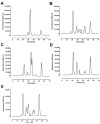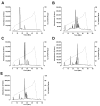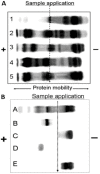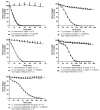Comparative studies of the venom of a new Taipan species, Oxyuranus temporalis, with other members of its genus
- PMID: 24992081
- PMCID: PMC4113736
- DOI: 10.3390/toxins6071979
Comparative studies of the venom of a new Taipan species, Oxyuranus temporalis, with other members of its genus
Abstract
Taipans are highly venomous Australo-Papuan elapids. A new species of taipan, the Western Desert Taipan (Oxyuranus temporalis), has been discovered with two specimens housed in captivity at the Adelaide Zoo. This study is the first investigation of O. temporalis venom and seeks to characterise and compare the neurotoxicity, lethality and biochemical properties of O. temporalis venom with other taipan venoms. Analysis of O. temporalis venom using size-exclusion and reverse-phase HPLC indicated a markedly simplified "profile" compared to other taipan venoms. SDS-PAGE and agarose gel electrophoresis analysis also indicated a relatively simple composition. Murine LD50 studies showed that O. temporalis venom is less lethal than O. microlepidotus venom. Venoms were tested in vitro, using the chick biventer cervicis nerve-muscle preparation. Based on t90 values, O. temporalis venom is highly neurotoxic abolishing indirect twitches far more rapidly than other taipan venoms. O. temporalis venom also abolished responses to exogenous acetylcholine and carbachol, indicating the presence of postsynaptic neurotoxins. Prior administration of CSL Taipan antivenom (CSL Limited) neutralised the inhibitory effects of all taipan venoms. The results of this study suggest that the venom of the O. temporalis is highly neurotoxic in vitro and may contain procoagulant toxins, making this snake potentially dangerous to humans.
Figures






Similar articles
-
Isolation and Pharmacological Characterization of α-Elapitoxin-Ot1a, a Short-Chain Postsynaptic Neurotoxin from the Venom of the Western Desert Taipan, Oxyuranus temporalis.Toxins (Basel). 2016 Feb 29;8(3):58. doi: 10.3390/toxins8030058. Toxins (Basel). 2016. PMID: 26938558 Free PMC article.
-
The effects of antivenom on the in vitro neurotoxicity of venoms from the taipans Oxyuranus scutellatus, Oxyuranus microlepidotus and Oxyuranus scutellatus canni.Toxicon. 1999 Dec;37(12):1771-8. doi: 10.1016/s0041-0101(99)00118-x. Toxicon. 1999. PMID: 10519654
-
Variations in the pharmacological profile of post-synaptic neurotoxins isolated from the venoms of the Papuan (Oxyuranus scutellatus canni) and coastal (Oxyuranus scutellatus scutellatus) taipans.Neurotoxicology. 2010 Mar;31(2):239-43. doi: 10.1016/j.neuro.2009.12.009. Epub 2009 Dec 29. Neurotoxicology. 2010. PMID: 20036687
-
Neurotoxins from Australo-Papuan elapids: a biochemical and pharmacological perspective.Crit Rev Toxicol. 2008;38(1):73-86. doi: 10.1080/10408440701703964. Crit Rev Toxicol. 2008. PMID: 18161503 Review.
-
In vitro neuromuscular activity of snake venoms.Clin Exp Pharmacol Physiol. 2002 Sep;29(9):807-14. doi: 10.1046/j.1440-1681.2002.03740.x. Clin Exp Pharmacol Physiol. 2002. PMID: 12165047 Review.
Cited by
-
Body Temperature Drop as a Humane Endpoint in Snake Venom-Lethality Neutralization Tests.Toxins (Basel). 2023 Aug 26;15(9):525. doi: 10.3390/toxins15090525. Toxins (Basel). 2023. PMID: 37755951 Free PMC article.
-
In Vitro Tests for Assessing the Neutralizing Ability of Snake Antivenoms: Toward the 3Rs Principles.Front Immunol. 2021 Jan 11;11:617429. doi: 10.3389/fimmu.2020.617429. eCollection 2020. Front Immunol. 2021. PMID: 33505403 Free PMC article.
-
Assessment of the Artemia salina toxicity assay as a substitute of the mouse lethality assay in the determination of venom-induced toxicity and preclinical efficacy of antivenom.Toxicon X. 2024 Apr 3;22:100195. doi: 10.1016/j.toxcx.2024.100195. eCollection 2024 Jun. Toxicon X. 2024. PMID: 38606385 Free PMC article.
-
Assessing a 6-h endpoint observation time in the lethality neutralization assay used to evaluate the preclinical efficacy of snake antivenoms.Toxicon X. 2021 Nov 23;12:100087. doi: 10.1016/j.toxcx.2021.100087. eCollection 2021 Nov. Toxicon X. 2021. PMID: 34888521 Free PMC article.
-
Isolation and Pharmacological Characterization of α-Elapitoxin-Ot1a, a Short-Chain Postsynaptic Neurotoxin from the Venom of the Western Desert Taipan, Oxyuranus temporalis.Toxins (Basel). 2016 Feb 29;8(3):58. doi: 10.3390/toxins8030058. Toxins (Basel). 2016. PMID: 26938558 Free PMC article.
References
-
- Wüster W., Dumbrell A.J., Hay C., Pook C.E., Williams D.J., Fry B.G. Snakes across the Strait: Trans-Torresian phylogeographic relationships in three genera of Australasian snakes (Serpentes: Elapidae: Acanthophis, Oxyuranus, and Pseudechis. Mol. Phylogenet. Evol. 2005;34:1–14. doi: 10.1016/j.ympev.2004.08.018. - DOI - PubMed
-
- Brennan K.E.C., Morley T., Hutchinson M., Donnellan S. Redescription of the western desert taipan, Oxyuranus temporalis (Serpentes: Elapidae), with notes on its distribution, diet and genetic variation. Aust. J. Zool. 2012;59:227–235.
-
- Doughty P., Maryan B., Donnellan S.C., Hutchinson M.N. A new species of taipan (Elapidae: Oxyuranus) from central Australia. Zootaxa. 2007;1422:45–58.
-
- Shea G.M. A possible second record of the Central Ranges Taipan, Oxyuranus temporalis (Elapidae) Herpetofauna. 2007;37:95–97.
Publication types
MeSH terms
Substances
LinkOut - more resources
Full Text Sources
Other Literature Sources

